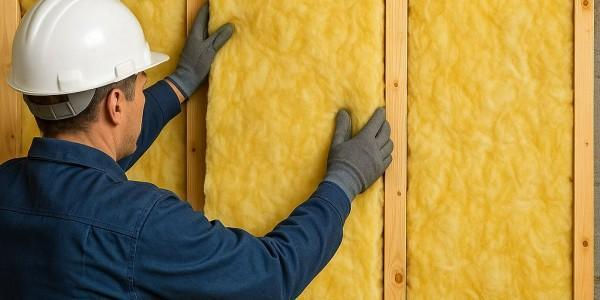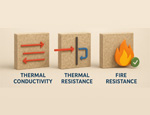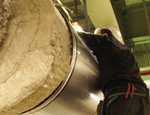- Blogs
- The 3 Pillars of Building Insulation: Thermal, Acoustic & Fire

In today’s fast-growing urban environments, buildings are designed for much more than just a space they are crafted for comfort, safety, and efficiency. One unsung hero behind all of this is insulation. While often associated with temperature control, insulation plays a crucial role in acoustics and fire safety too.
This blog explores the fundamentals of building insulations through the lens of thermal, acoustic and fire protection the three pillars of people comfort and building performance.
What is Building Insulation?
It basically refers to the use of materials and systems designed to lessen the transfer of heat, sound or fire through walls, roofs, floors or even ducts. The right insulation once selected basis technical calculations enhance energy efficiency, indoor thermal and acoustic comfort and safety while being sustainable as a material.
Thermal Insulation – Keeping Temperatures in Check

Thermal insulation in buildings minimizes the transfer of heat between indoor and outdoor spaces, and vice versa to help maintain consistent and comfortable temperature maintained inside the building. It can also enable minimizing the heat transfer between the indoor rooms as well to ensure efficient use of electricity for cooling.
Some of the key benefits include:
- Energy Efficiency: Reduces reliance on heating/ cooling systems
- Cost Saving: Lowers energy bills
- Comfort: Maintains room temperatures
The thermal performance of insulation is measured by the thermal resistance of the insulation. It is a measure of how effectively a material resists the flow of heat. The higher the R-value, the better the insulation. Common thermal insulation materials in buildings such as glass wool and stone wool are considered effective because of their low thermal conductivity and high R-value. These thermal insulation materials contribute significantly to overall building efficiency and occupant comfort.
Acoustic Insulation – Creating Quiet, Comfortable Spaces

Acoustic insulation ensures the sound levels in a given environment are controlled, comfortable enough for the inhabitant to work/stay in that environment. It helps create peaceful interiors by using specially designed acoustic insulation materials that either absorb or block sound. Acoustics can be classified into two key categories:
- Sound absorption where it focuses on reducing the echoes and the reverberation in a space by absorbing sound energy. It is measured using the Noise Reduction Coefficient or NRC
- Sound isolation focuses on preventing the sound from travelling between spaces by blocking transmission. It is measured using Sound Transmission Class or STC
Acoustics play a key role in many spaces including:
- Homes: reduces traffic noise, neighbor sounds, and echoes
- Office and Commercial Spaces: Improves concentration and productivity of the employees
- Hospitality Projects: Enhances privacy, productivity and comfort
- Auditoriums: Improves overall sound quality
Mineral wool insulations (Glass Wool and Stone (Rock) Wool) are designed to achieve as high as 1 NRC for superior sound absorption, making them effective acoustic insulation materials.
Fire Safety – Enhancing Building Safety

Fire insulation helps in contain the spread of fire in a space, providing the necessary time for the people to evacuate a space and minimize property damage. Some of the key functions of fire insulation include:
- Compartmentalization: Prevents fire from spreading between rooms
- Heat protection: Shields structural elements and people from the heat
- Passive Fire Safety: Works without mechanical systems
An insulation, when selecting from the fire perspective, should have the following characteristics:
- It should not aid in fire propagation
- It should not emit smoke
- It should not act as a fuel to fire
- It should not melt and form droplets
With the rise of global warming, the number of fire incidents has been increasing in India and worldwide. According to India’s National Crime Records Bureau, fire related incidents cause over 25,000 deaths annually, with 60+ people losing their lives every day. These alarming numbers underscore the need for effective passive fire protection systems where insulation plays a key role.
Conclusion
It’s clear that insulation isn’t only about thermal comfort it also plays a crucial role in sound control and fire safety. Using it only for thermal may leave the building vulnerable to noise pollution and potential fire hazards. Hence, it is essential to choose the right building insulation material with a holistic perspective that considers all performance aspects.
At Saint-Gobain India – Insulation Business, we are committed to delivering high-performance, sustainable insulation solutions that enhance thermal comfort, acoustic control, and fire safety. As one of the leading building insulation companies, we offer glass wool and stone wool solutions that are engineered to meet and exceed the highest global standards for performance, safety, and sustainability.
Stay tuned to our blogs as we explore more ways insulation can transform your buildings inside and out.
If you are looking to learn more or have a query about insulation solutions, feel free to reach out to us at sgindia.insulation@saint-gobain.com.
Latest Blogs




